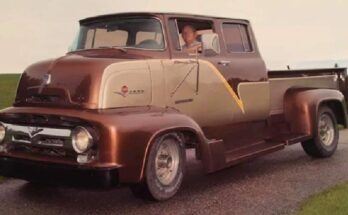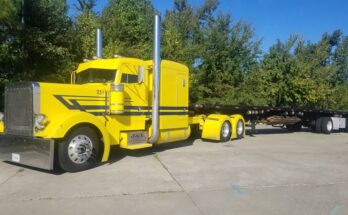Yes, an old British Scammell truck.
This one’s a Scammell Highwayman Old Pecullier, not sure which year. Scammell Lorries made a lot of specialist and military off-highway vehicles from 1921 to 1988, and they all had funky names like Rigid, Showtrac, Handyman, Trunker, Contractor, Crusader, and Commander Tank Transporter, to name some of the most popular.
This one’s the Highwayman Old Pecullier. They were part of a series of trucks Scammell put out after 1955 when Scammell came under Leyland Motors Ltd in 1955 and got access to ready-made components within the Leyland group, allowing the replacement of the “lightweight” range with the Highwayman, Routeman, and Handyman lorries.
Both the tractor units could be configured up to 50 tons (50.8 Tonnes or 55 short tons), and complemented by the full range of Scammell trailers made at the Moor Park works, allowed the company to continue production in specialist and military markets.
A list of the cool trucks Scammell put out before it closed in 1988. How many of these names are you familiar with?
80 Tonner
100 Tonner
Commander
Constructor
Contractor
Crusader
Explorer
Handyman
Highwayman
Himalayan
Mechanical Horse, Scarab and Townsman
Mountaineer
Pioneer, Pioneer Semi-trailer (tank transporter)
Rigid Eight
Rigid Six
Routeman
S24
S26
Samson
Showtrac
Trunker
Scammell as a company started as a late-Victorian period wheelwright and coach-building business, G Scammell & Nephew Ltd in Spitalfields, London. George Scammell, the founder, was joined by his nephew Richard and Richard’s sons Alfred and James. By the early 1900s, the firm had become financially stable, providing maintenance to customers of Foden steam wagons. One such customer, Edward Rudd, had imported a Knox Automobile tractor from the United States, and impressed with its low weight/high hauling power had asked Scammell if they could make a similar model of their own.
However, the outbreak of war in 1914 stopped the project and presented itself as a turning point in road transport history. Mechanical transport was seen to work, proving its vast potential beyond doubt to forward-thinking companies such as Scammell.
George Scammell’s great nephew, Lt Col Alfred Scammell, was injured and invalided out of the army, and he was able to apply the practical experience he had gained during the war and began developing the articulated six wheeler. Percy G Hugh, chief designer, conceived the idea and at the 1920 Commercial Motor Show 50 orders were taken for the new design.
The vehicle’s very low axle weight allowed it to carry 7.5 tonnes payload legally at 12 miles per hour (19 km/h), rather than being limited to 5 mph.
Nowadays we see Scammel trucks as classic trucks, such as this one, and a lot of people still like to see the designs of these old models, when there was, indeed, so much variation in the body shapes, engines and parts between auto manufacturers.
 " >
" >


